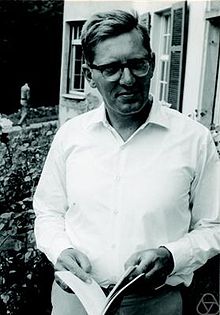Nicolaas Govert de Bruijn
Nicolaas Govert de Bruijn (born July 9, 1918 in The Hague ; † February 17, 2012 in Nuenen ) was a Dutch mathematician who mainly dealt with analysis , number theory , combinatorics and computer science (discrete mathematics).
Live and act
De Bruijn graduated from high school in 1934 and studied at the University of Leiden from 1936 . From 1939 to 1944 he was an assistant in mathematics at the Technical University in Delft (while he studied in Leiden until 1941 and then in Amsterdam ) and received his doctorate in 1943 at the University of Amsterdam under Jurjen Koksma ( modular forms in several variables ). After two years in the Philips research laboratory in Eindhoven (in which he dealt with the equations for oscillating circuits, waveguide theory, antenna theory, among other things) he was professor in Delft from 1946 to 1952. At that time he already published several works with Paul Erdős (sentence by De Bruijn-Erdős 1948). From 1952 to 1960 he was a professor in Amsterdam and then until his retirement in 1984 at the Technical University of Eindhoven . 1960 to 1984 he was a scientific advisor at Philips. In 1959 he was a Gauss professor in Göttingen .
In combinatorics, for example, he generalized George Pólya's counting theory for graphs and groups. According to him, De Bruijn sequences named and, related to De Bruijn graphs , which he shares with Tatjana van AARDENNE-Ehrenfest introduced 1,951th Also in 1951 he proved a generalization of Sperner's lemma . He also dealt with automaton theory, various games (such as solitaire, card games, pentominoes, games on graphs), packing problems and developed the computer language Automath for automatic reasoning in the late 1960s. De Bruijn also dealt with quasicrystals ( Penrose tiling ) and, since the 1970s, with mathematical models for brain functions such as memory. His book on asymptotic developments in analysis is considered a standard work, but it is not a monograph in the true sense of the word, but rather emphasizes the methods used.
In 1951, together with Paul Erdös , he proved the theorem of de Bruijn and Erdös in graph theory : The chromatic number of an infinite graph is, if it is finite, equal to the maximum chromatic number of all its finite subgraphs. There is also a theorem from de Bruijn and Erdös in incidence geometry : Let P be a configuration of points in the projective plane that do not all lie on a straight line. For the number of straight lines which are defined by the points of P, then: . If P is the projective plane or exactly points lie on a straight line.
In 1985 he received the Snellius Medal (awarded only every nine years), mainly for work on Automath. He is an honorary member of the Dutch Mathematical Society and has been a member of the Dutch Academy of Sciences since 1957 . De Bruijn is a knight of the Dutch lion. In 1970 he was invited speaker at the International Congress of Mathematicians in Nice ( Recent developments in enumeration theory ). In 1991 he received the AKZO Prize and in 2003 the Lifetime Achievement Prize from the Dutch Society for Computer Science.
He has been married since 1944 and has four children.
Fonts
- Asymptotic Methods in Analysis. North Holland 1958, Dover 1981.
- Pólya's counting theory, patterns for graphs and chemical compounds . In: Konrad Jacobs (Ed.): Selecta mathematica III (= Heidelberger Taschenbücher Volume 86 ). Springer, Berlin, Heidelberg, New York 1971, ISBN 3-540-05333-6 , pp. 1–26 ( [1] [PDF; accessed July 11, 2019]).
Web links
- Homepage with bibliography and many of his works online
- John J. O'Connor, Edmund F. Robertson : Nicolaas Govert de Bruijn. In: MacTutor History of Mathematics archive .
- Mathematics Genealogy Project
- De Bruijn sequence at Math World with link to de Bruijn graph
- Booklet Nieuw Archief voor Wiskunde zu de Bruijn, March 2013
Remarks
- ↑ His first publication was in 1937 on integrals of the Riemann zeta function
- ^ A combinatorial problem. Royal Dutch Academy of Sciences, Vol. 49, 1946, p. 758.
- ↑ De Bruijn, Erdös, A color problem for infinite graphs and a problem in the theory of relations, Nederl. Akad. Wetensch. Proc. Ser. A, Vol. 54, 1951, pp. 371-373
- ^ De Bruijn, Erdös, On a combinatioral [sic] problem, Indagationes Mathematicae, Volume 10, 1948, pp. 421-423
| personal data | |
|---|---|
| SURNAME | Bruijn, Nicolaas Govert de |
| BRIEF DESCRIPTION | Dutch mathematician |
| DATE OF BIRTH | July 9, 1918 |
| PLACE OF BIRTH | The hague |
| DATE OF DEATH | 17th February 2012 |
| Place of death | Nuenen |





